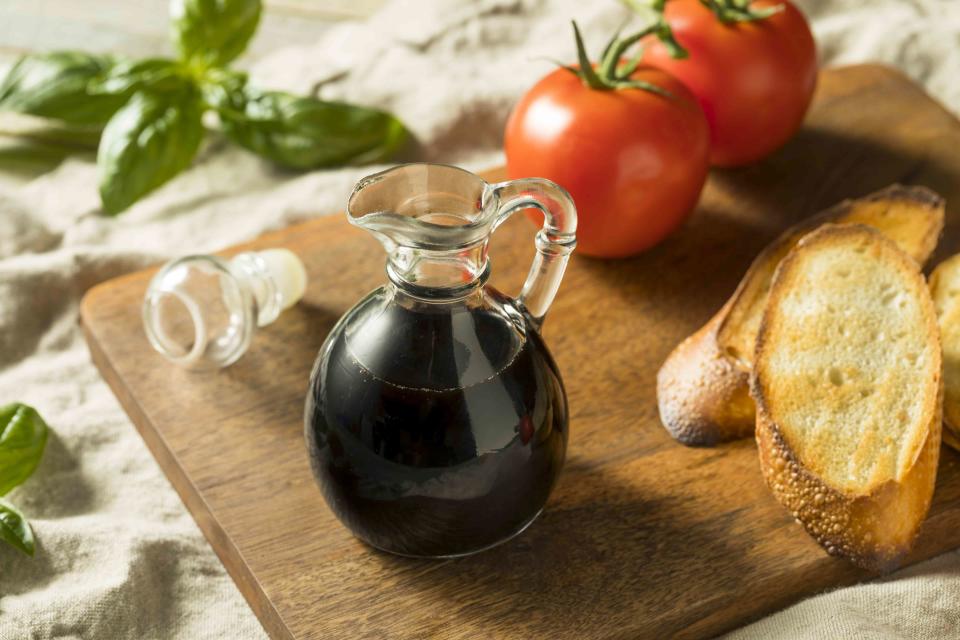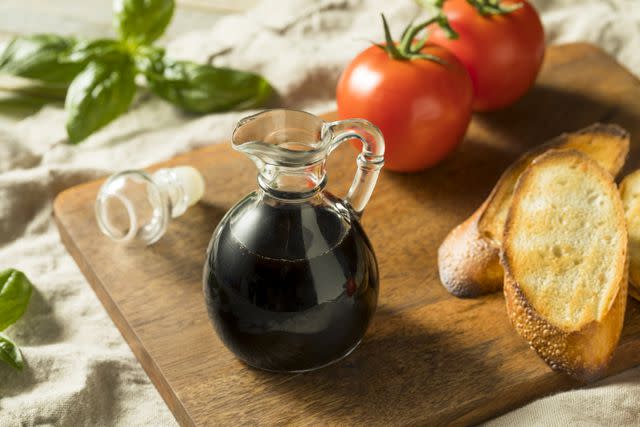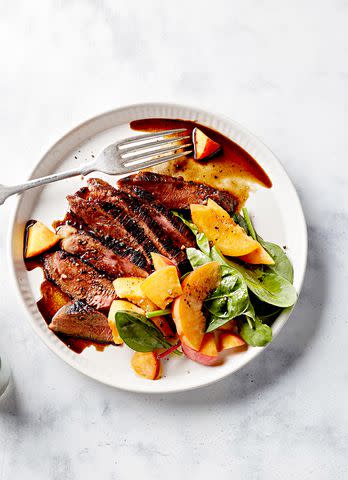What Is Balsamic Vinegar? Everything You Need to Know
There are many different types of balsamic vinegar—here's how to know when you're buying the real deal.

bhofack2/Getty Images
You’ve likely mixed balsamic vinegar into a salad dressing or drizzled a little over some fresh tomatoes and mozzarella, but how much do you actually know about that bottle sitting in your pantry? As it turns out, there are many different types of balsamic vinegar that vary widely in terms of both quality and price, ranging from a few dollars for a 16-ounce bottle to hundreds of dollars for just an ounce of the good stuff. So, what exactly is balsamic vinegar, and what should you look for when buying a bottle? Read on for our guide to this essential pantry staple, including a breakdown of the different types and our favorite ways to use them in the kitchen.
Related: This Balsamic Vinegar Substitute Replicates the Tangy Taste
What Is Balsamic Vinegar?
Balsamic vinegar (or aceto balsamico, as it’s known in Italy) is made from cooked grape must (the fresh, unfermented juice of grapes). In its most pure form, the balsamic vinegar that’s been produced in Italy for centuries is made only from grape must that is aged in wood for several years—sometimes decades. Dark in color, it has a rich flavor that’s sweet and a little tangy at the same time. But because traditional balsamic vinegar requires such a lengthy production process, other categories of balsamic vinegar have emerged on the market over time.

bhofack2/Getty Images
Types of Balsamic Vinegar
Balsamic vinegars can vary widely in taste and consistency but typically fall into one of three categories: traditional balsamic vinegar, balsamic vinegar of Modena IGP, and commercial balsamic vinegar.
Traditional Balsamic Vinegar
Traditional balsamic vinegar, or aceto balsamico tradizionale, is the highest quality you can get. This balsamic carries a DOP (Protected Designation of Origin) stamp from the European Union, which guarantees that an ingredient was produced in a given region according to traditional methods. In order for a balsamic vinegar to be called traditional, it must be produced according to strict regulations. Traditional balsamic vinegar can only be made from 100% grape must—no other ingredients are permitted—from seven approved grapes grown in the Italian regions of Modena and Reggio Emilia. It must be aged in wooden casks for a minimum of 12 years (known as “invecchiato,” or aged), though some producers age their balsamic for 25 years and up (known as “extravecchio,” or extra aged).
Traditional balsamic vinegar is a premium product and a complex ingredient—sweet yet also acidic, with a thick, syrupy consistency. Because it’s the highest quality version on the market, traditional balsamic vinegar is more expensive than what you might find at your usual supermarket, often selling for hundreds of dollars an ounce. It’s sold in a distinct, wax-sealed bottle: a bulb shape if it was produced in Modena or an inverted tulip shape if produced in Reggio Emilia.
Balsamic Vinegar of Modena IGP
One step down from traditional balsamic vinegar is balsamic vinegar of Modena IGP, or aceto balsamico di Modena IGP. Though not as rigorous as the criteria for DOP distinction, the IGP label, which stands for “protected geographical indication,” is another mark of high quality—it indicates that the balsamic vinegar was produced and bottled in Modena according to certain regulations. IGP balsamic vinegars are made with must from the same seven grape varietals as traditional balsamic, but the grapes can be grown anywhere in the world. Unlike traditional balsamic vinegars, IGP vinegars only need to contain 20% cooked grape must, and wine vinegar must be added in order to reach 6% acidity. Caramel is also permitted, up to 2%, to stabilize the color. IGP balsamic vinegars also must be aged in wood for at least 60 days. Unlike traditional balsamic vinegar, they can be packaged in any size or shape of bottle. Look for the blue and yellow IGP stamp, which features two hills surrounded by a circle of stars.
Claudio Stefani Giusti, owner and CEO of Acetaia Giusti, which has been producing balsamic vinegar in Modena since 1605, notes that balsamic vinegars within the IGP class can vary widely. You can still get a top-quality product at this level, as many producers use more than the required 20% grape must in their vinegars and age them for more than 60 days. “I believe that the choice that a consumer has to make is not necessarily between IGP and DOP,” Giusti says. “It should be between a mass market or a premium, and the premium product could absolutely be IGP.”
Commercial Balsamic Vinegar
Balsamic vinegars that don’t meet DOP or IGP standards are generally referred to as commercial-grade. These balsamic vinegars do not need to be made in Italy, and because they are not subject to the strict regulations of traditional or IGP balsamic, producers are free to add ingredients such as wine vinegar, thickeners, and sweeteners to mimic the taste and texture of higher grades of balsamic vinegar. Balsamic vinegars in this category can range widely in quality, but are often more liquid and less complex in flavor. An easy rule of thumb to gauge quality is to look at the ingredient list and the order in which they appear—opt for a bottle where only grapes or grape must are listed (or, at the very least, they are the first ingredient listed).
Related: Every Vinegar Substitute You Need to Save Your Recipes
How Is Balsamic Vinegar Made?
The production process for balsamic vinegar depends on the grade of the product, but true balsamic vinegar is made by fermenting and aging grape must. The grape must is first cooked down to reduce and concentrate, causing the natural sugars to caramelize, and then fermented. It’s then aged in wood—often mulberry, juniper, ash, cherry, acacia, chestnut or oak—and moved into progressively smaller casks (known as a “batteria”) as it ages.
The grapes themselves are key to a quality balsamic vinegar, and DOP and IGP vinegars are made only from seven different grape varietals: Sangiovese, Lambrusco, Trebbiano, Ancellotta, Albana, Fortana and Montuni. Because these grapes, which typically produce wines with lower alcohol, are low in tannins and ferment quickly, they’re better suited for turning into vinegar than other varietals.
“Balsamic vinegar was born in Modena because the grapes of this region were not giving a great wine,” Giusti says. “Lambrusco is definitely not Sassicaia, Amarone, Barolo—we are all aware of that. People in Tuscany or in Piedmont would have never done a vinegar with their amazing grapes and the amazing wines that they were making. But as people in Modena found themselves with the terroir and with grapes that were producing wine with lower alcohol, they decided to cook them down to preserve them. After they cooked it, they realized it was becoming an interesting vinegar. Balsamic vinegar is not the result of a super grape; it’s the result of a super process that started from the fact that the grapes were not special. If you used Nebbiolo, you would not get a good result—you need these grapes with this particular acidity and characteristics that are perfect for the vinegar.”
How to Store Balsamic Vinegar
Stored properly, balsamic vinegar has a long shelf life. Store it in a tightly sealed bottle in a cool, dark place out of direct sunlight. Avoid storing balsamic vinegar in the refrigerator, which can cause it to thicken.

How Long Does Balsamic Vinegar Last?
When stored properly, balsamic vinegar will last for up to 5 years. It's best to consume balsamic vinegar within 3 to 5 years of opening.
How to Use Balsamic Vinegar
If you’ve splurged on a nice bottle of traditional balsamic vinegar, make it count. Traditional balsamic vinegar is not intended for cooking; instead, let it shine over some fresh strawberries or nutty Parmesan cheese. It’s great in sweet and savory dishes alike; drizzle a little over risotto, vanilla ice cream or creamy panna cotta. Giusti says to avoid using the good stuff on bread, which will absorb the vinegar and lose its texture; instead, he likes to add a little to fresh pears. Traditional balsamic vinegar is also becoming a popular cocktail ingredient—Stanley Tucci even used Giusti’s Banda Rossa balsamic in his viral Negroni recipe from “Searching for Italy.”
If you’re looking for a balsamic to use in salad dressing, sauce or as a glaze for meat, opt for IGP or commercial-grade. Balsamic vinegar is a natural match for burrata and cherry tomatoes in this take on a classic caprese, and it adds a depth of flavor to this easy balsamic chicken and vegetables recipe.
For more Better Homes & Gardens news, make sure to sign up for our newsletter!
Read the original article on Better Homes & Gardens.

